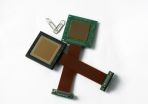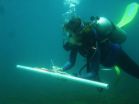(Press-News.org) More and more car manufacturers are equipping their vehicles with image sensors – e.g. to register the presence of pedestrians or vehicles in the blind spot or to detect obstacles when parking. The sensors must be able to function in extremely high temperatures and in blazing sunlight. If they are installed behind the rear view mirror or on the instrument panel, for example, they can get very hot. The Fraunhofer Institute for Microelectronic Circuits and Systems IMS in Duisburg has developed a CMOS (complementary metal oxide semiconductor) image sensor for an industrial customer which can withstand temperatures ranging from -40 to +115 degrees Celsius. The CCD (charged coupled device) image sensors available up to now fail when the temperature goes beyond about 60 degrees. »Our chip is not only heat-resistant, it even functions at arctic temperatures,« says Werner Brockherde, head of department at the IMS.
The research scientists have succeeded in developing pixels which exhibit an extremely low dark current. This reduction of residual current, which flows in complete darkness, makes it possible to capture very high-quality images even in extreme heat. »It was not easy to achieve a low dark current. An increase in temperature of just eight degrees doubles the dark current, resulting in image noise and reduced dynamics. Ghosting occurs in the form of artifacts or fuzziness and degrades the image,« explains Brockherde.
A further special feature of the sensor is its image size of 2.5 x 2.5 centimeters. This offers the advantage that for special applications with weak illumination or for capturing images in the infrared or UV range the sensor can be connected directly to an electronic image intensifier. The sensor has a resolution of 256 x 256 pixels. Its high dynamic range or exposure latitude of 90 decibels provides increased contrast and optimized detail accuracy both in shadow as well as in very bright areas. Nuances of light are precisely reproduced. Thanks to its efficient light absorption, the image sensor reacts with high sensitivity even in weak light conditions. It is therefore also suitable for night vision equipment. What's more, the chip supports cameras with synchronous as well as asynchronous shutters. The synchronous shutter prevents motion artifacts, for instance when recording rapid movements, reducing movement fuzziness. The rolling shutter permits a higher image frame rate and continuous image recording. The effect of this is to minimize image noise. »We produced the sensor in a standard process using 0.5 micrometer CMOS technology in our own semiconductor factory. We also produce special components here for industrial customers,« states the scientist, reflecting the expertise of the Institute. In addition to the automotive sector he can see further potential markets: »Our chip is suitable for deployment in chemical and steel production facilities, where it can be used for process and quality control. Very high temperatures prevail, for example, in rolling mills where sheet metal is produced.« The CMOS image sensor will be on show at the Vision trade fair from November 9 to 11, 2010, in Stuttgart (Stand 6 D12).
INFORMATION:
Image sensors for extreme temperatures
2010-09-20
ELSE PRESS RELEASES FROM THIS DATE:
Taking the pulse of coral reefs
2010-09-20
Healthy reefs with more corals and fish generate predictably greater levels of noise, according to researchers working in Panama. This has important implications for understanding the behaviour of young fish, and provides an exciting new approach for monitoring environmental health by listening to reefs.
Contrary to Jacques Cousteau's 'Silent World', coral reefs are surprisingly noisy places, with fish and invertebrates producing clicks and grunts which combine to produce cacophonies of noise. Each reef is subtly different depending on the size and composition of the ...
Earth's highest coastal mountain on the move
2010-09-20
The rocks of Colombia's Sierra Nevada de Santa Marta—the highest coastal mountain on Earth—tell a fascinating tale: The mountain collides and then separates from former super-continents. Volcanoes are born and die. The mountain travels from Peru to northern Colombia and finally rotates in a clockwise direction to open up an entirely new geological basin. Smithsonian scientists were part of a four-year project to study Santa Marta's geological evolution. Their findings are published in the October 2010 special issue of the Journal of South American Earth Sciences.
The study ...
Returning troops face both physical and mental challenges
2010-09-20
Is the US health system comprehensively meeting the needs of returning veterans? With the recent attention to mental illness in returning soldiers, and post-traumatic stress disorder (PTSD) in particular, little research has focused on the medical care needs of those returning from Operation Enduring Freedom/Operation Iraqi Freedom, according to Dr. Susan Frayne, from the VA Palo Alto Health Care System and Stanford University, and colleagues.
Their research highlights that veterans suffering from PTSD also suffer more medical illnesses than do those with no mental health ...
Cholesterol drug may have role in treating prostate cancer
2010-09-20
TORONTO, Ont., Sept. 20, 2010 – A drug commonly prescribed for people with high cholesterol may also be effective in treating prostate cancer, according to new research by Dr. Xiao-Yan Wen at St. Michael's Hospital.
Rosuvastatin—a statin drug sold as Crestor—suppressed the growth of transplanted human prostate cancer cells in mice.
"Our data provided solid pre-clinical evidence and a strong rationale for clinical trials of statins in the treatment of prostate cancer," said Wen, whose research appears in the September issue of European Urology, the journal of the European ...
Study: Privacy key obstacle to adopting electronic health records
2010-09-20
The United States could achieve significant health care savings if it achieved widespread adoption of electronic health records (EHRs), but insufficient privacy protections are hindering public acceptance of the EHR concept, according to a new paper from researchers from North Carolina State University. The paper outlines steps that could be taken to boost privacy and promote the use of EHRs.
"Electronic health records could reduce costs in the U.S. by an estimated $80 to 100 billion each year," says Dr. David Baumer, head of the business management department at NC State ...
Kids and diabetes risk: Do chromosomes hold new clues?
2010-09-20
Children who have a high risk of developing type 2 diabetes might be identified earlier by way of tell-tale genetic indicators known as biomarkers. Some of those new biomarkers might be pinpointed in research led by Nancy F. Butte and funded by the U.S. Department of Agriculture (USDA) and the U.S. Department of Health and Human Service's National Institutes of Health.
Butte is with the USDA Agricultural Research Service (ARS) Children's Nutrition Research Center at Baylor College of Medicine in Houston, Texas, where she is a professor of pediatrics. ARS is USDA's principal ...
Plague researchers race to beat bioterrorists
2010-09-20
Saranac Lake, N.Y. – Given the many pressing concerns of the day, fear of plague probably isn't what causes most Americans to lose sleep. But for those whose responsibility it is to combat bioterrorism, plague is among the highest priorities. Those charged with that mission include scientists like medical researcher Steve Smiley, whose lab at the Trudeau Institute is working to develop a vaccine that will protect the public against weaponized forms of plague. The Institute, which is dedicated to studying how the immune system responds to infectious diseases, is at the forefront ...
No pain in the hospital -- wishful thinking or reality?
2010-09-20
More than 80% of hospitalized patients suffer more severe pain than necessary. This is the conclusion of Christoph Maier (Bochum University Hospital, Bochum, Germany) and his coauthors in their interim report of the Pain-Free Hospital Project ("Schmerzfreies Krankenhaus"), which appears in the current issue of Deutsches Ärzteblatt International (Dtsch Arztebl Int 2010; 107[36]: 607-14). The project, which was initiated in 2003, has the goal of improving pain management in hospitals across Germany.
To study the quality of pain therapy, the authors evaluated anonymous ...
Fidgety children are on the rise
2010-09-20
Hyperkinetic disorders among children and adolescents are becoming increasingly common. In the current issue of Deutsches Ärzteblatt International, Ingrid Schubert of the PMV Research Group at the University of Cologne and her colleagues address the question how this has affected the frequency of prescriptions for methylphenidate, a stimulant drug that is used to treat such disorders (Dtsch Arztebl Int 2010; 107[36]: 615¬21). The authors analyzed data concerning tens of thousands of persons insured by the AOK health insurance company in the German state of Hesse over the ...
Effects of chemoradiation therapy by using capecitabine on gastric cancer patients
2010-09-20
Gastric cancer is a major cause of cancer deaths in the world. The outcome of large gastric tumors and those with lymph node involvement remains poor after surgical resection. The optimal adjuvant therapy after surgical resection remains to be determined. The most common strategies in the adjuvant treatment of gastric cancers include fluoropyrimidine-based chemotherapy with or without radiation. The introduction of capecitabine has largely replaced continuous-infusion 5-fluorouracil (5-FU) owing to its ease of administration. However, its efficacy is not proven in randomized ...



